
JEREMY BLACHMAN


is the author of two satirical novels about the legal profession, and a ghostwriter working with industry leaders. He and his wife, Nina, and sons, Micah (9) and Rafi (5), are members of WJC.


JEREMY BLACHMAN


is the author of two satirical novels about the legal profession, and a ghostwriter working with industry leaders. He and his wife, Nina, and sons, Micah (9) and Rafi (5), are members of WJC.
When Rabbi Arnowitz first proposed “joy” as the focal point for High Holidays 5784 and the upcoming fall edition of Kolot, I must confess my initial skepticism. Joy? Amid the cacophony of world events, the concept of joy appeared elusive, distant. Yet, as the submissions for this Kolot issue flooded in, a realization unfurled within me. The enigmatic essence of “joy” does not reside in external circumstances; it is not tethered to the tumultuous tides of the world. Rather, it emerges from the inner sanctum of one’s self. Life events ebb and flow, but it is the unchanging core of one’s self that holds the key to unlocking joy’s presence. That is not to say that we all experience joy in the same manner. In fact, as our cover shows, it is the mosaic of all our differences that blend together in order to create one harmonious symphony that is the Westchester Jewish Center. Additionally, it occurred to me that joy need not emanate solely from grandiose occasions, say a recent wedding or a bat mitzvah. Indeed, joy can occur at tender moments, so fragile that one might miss it and not appreciate its beauty and intricacy.
As always, Kolot would not be possible without the meticulous attention to detail and boundless creativity from my partner and our Editorial Services Director Katie Schlientz. Add in the discerning eyes of Jeremy Blachman and we’re blessed with a superstar editorial team… A team we’d like to expand! Please reach out if you’d like to write an article or if you have a suggestion on ways to make Kolot even richer. It is quite an undertaking to produce this labor of love, and we’d love more congregants to lend their expertise and passion to this project. If you’re interested, please email Katie at KLSchlientz@gmail.com.
As an editorial team, it is our wish for all of us on 5784 to greet one another with smiles and hugs and to be thankful that we can once again come together in joyful voice, song, and prayer.
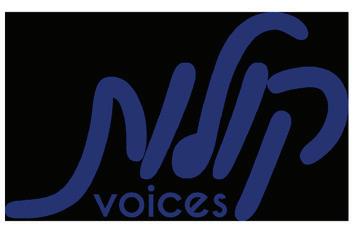
Joyfully yours,
Evan J. SchapiroAMY LEVINEKENNEDY has been the Curator of the Koslowe Gallery since 2011. A writer and editor, Amy also enjoys family time, exercise, and drawing greeting cards.
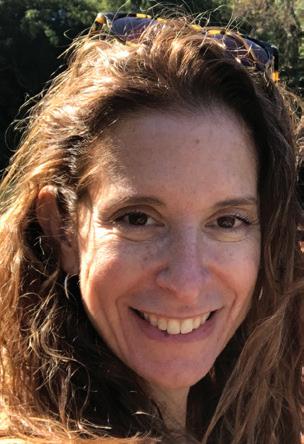
LAUREN MOSKOVITZ SHOLDER has lived in Larchmont for four years with her husband Scott and daughters Andi and Dani. Professionally, Lauren is in business development at an investment management firm.

TEKI-NAH
Why we won’t hear the shofar blown this year.

THE ART OF JOY
Finding joy in your life involves embracing the present, cultivating gratitude, and nurturing connections that bring warmth to your heart.
JOY AT THE BICENTENNIAL
Larry Thaler reflects on his enriching experience traveling America alongside fellow Jewish teens.
PARTY TIME
A photo recap of some of the fun post-Gala celebrations this summer.
WHICH APPLE ARE YOU?
As we prepare for Rosh Hashanah, it may be time to consider— which apple are you most like?
THE JOY OF JOURNEYING TOGETHER
Rabbi Jeffrey Arnowitz reflects on this year’s High Holiday theme—Joyful Together.
WJC’S RELIGIOUS SCHOOL MUSIC MAN
One of our very own introduces WJC children to the music that shaped his own upbringing.

7 WAYS TO ENGAGE YOUR CHILDREN IN THE HIGH HOLIDAYS
Actively engaging your children during the High Holidays fosters an educational experience throughout the entire season.
AL HIRSCHFELD AT THE KOSLOWE GALLERY
Our gallery curator explores the latest exhibit featuring the art of Broadway caricature.
WHAT’S IN A NAME?
WJC Member Howard Husock explores whether or not WJC should add a Hebrew name.
TIKKUN HAYAM ~ REPAIR THE SEA
As Jews, we’re meant to take care of the environment. This responsibility includes not just the land but also the oceans we depend on.
REWIND
A photo from the archives.
party time Lauren Moskovitz Sholder & Joanna Shlesinger
One of the distinctive elements of this year’s WJC Spring Gala, themed “A Night at the Riviera,” was the novel inclusion of summer sign-up parties. We sought to extend the celebration, ensuring there were more opportunities for members of the WJC community to come together in new, unique ways. Gala attendees eagerly enrolled in the various summer parties, ultimately culminating in nearly ten gatherings and attracting the participation of more than 100 WJC members. These gatherings not only served as additional fundraisers for the synagogue, but they also allowed our close-knit community to come together throughout the summer.
(Top) Basking in the beauty of Candlewood Lake, WJC members revel in a splendid gathering, complete with a barbecue and water activities, all set against the backdrop of Sherry and Larry Thaler’s charming cottage.


(Center) At WJC’s very own Yarn Bombing Party, members engaged in the art of yarn decoration. A particular tree positioned outside WJC served as the canvas for an outpouring of imaginative expressions.

(Bottom)
Nearly 30 WJC members traveled to Made in Mamaroneck for some painting and wine sipping.
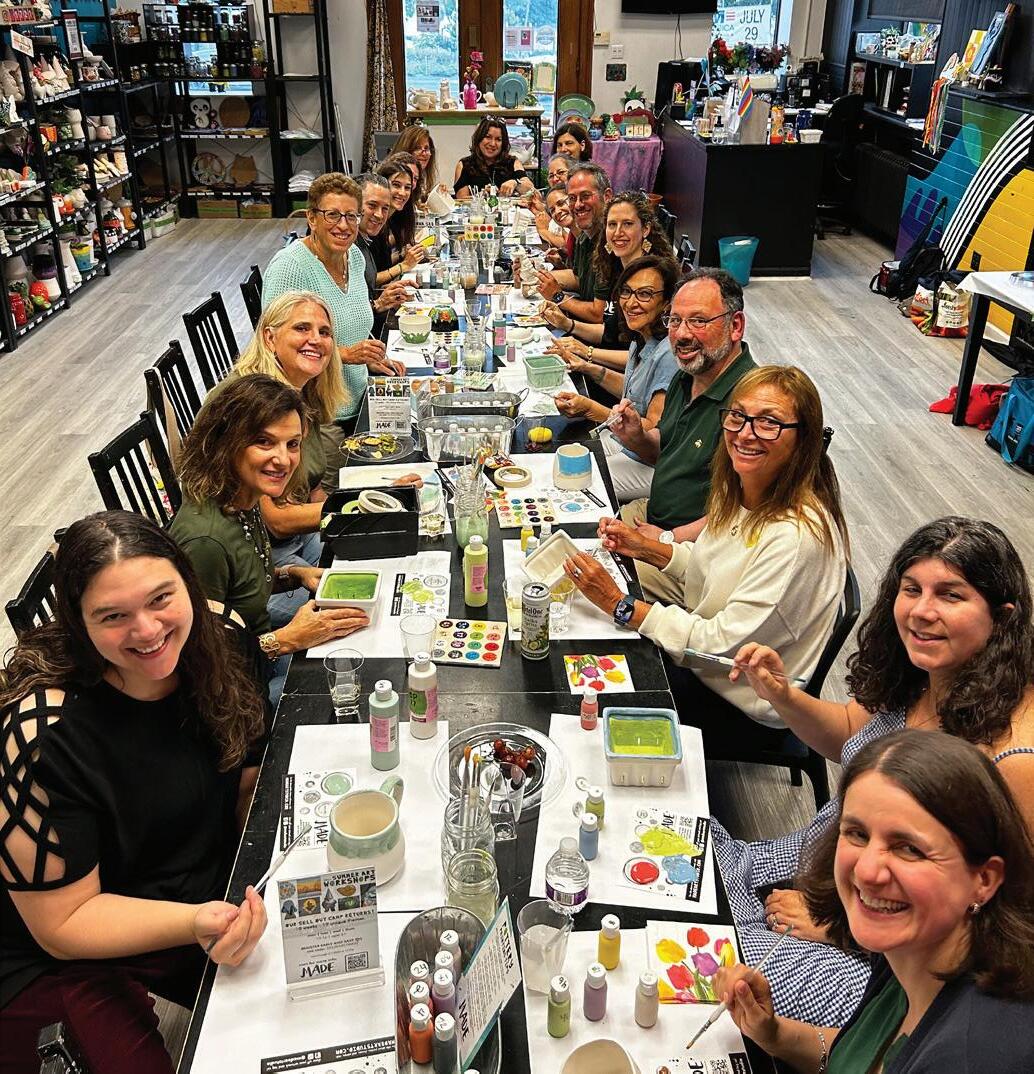
It is a long-standing tradition to welcome in Rosh Hashanah with symbolic foods that express our wishes for the coming year. Perhaps the most well-known of these traditions is the custom of eating apples and honey. This practice is first recorded in a 14thcentury legal code called Arba’ah Turim which said that German Jews ate apples and honey in order to bring sweetness into the New Year.
There are many kinds of apples. As we prepare for Rosh Hashanah, we might look for apples with certain flavors or to be used for dipping, cooking, or baking. Perhaps this year it’s time to consider, which apple are you most like?
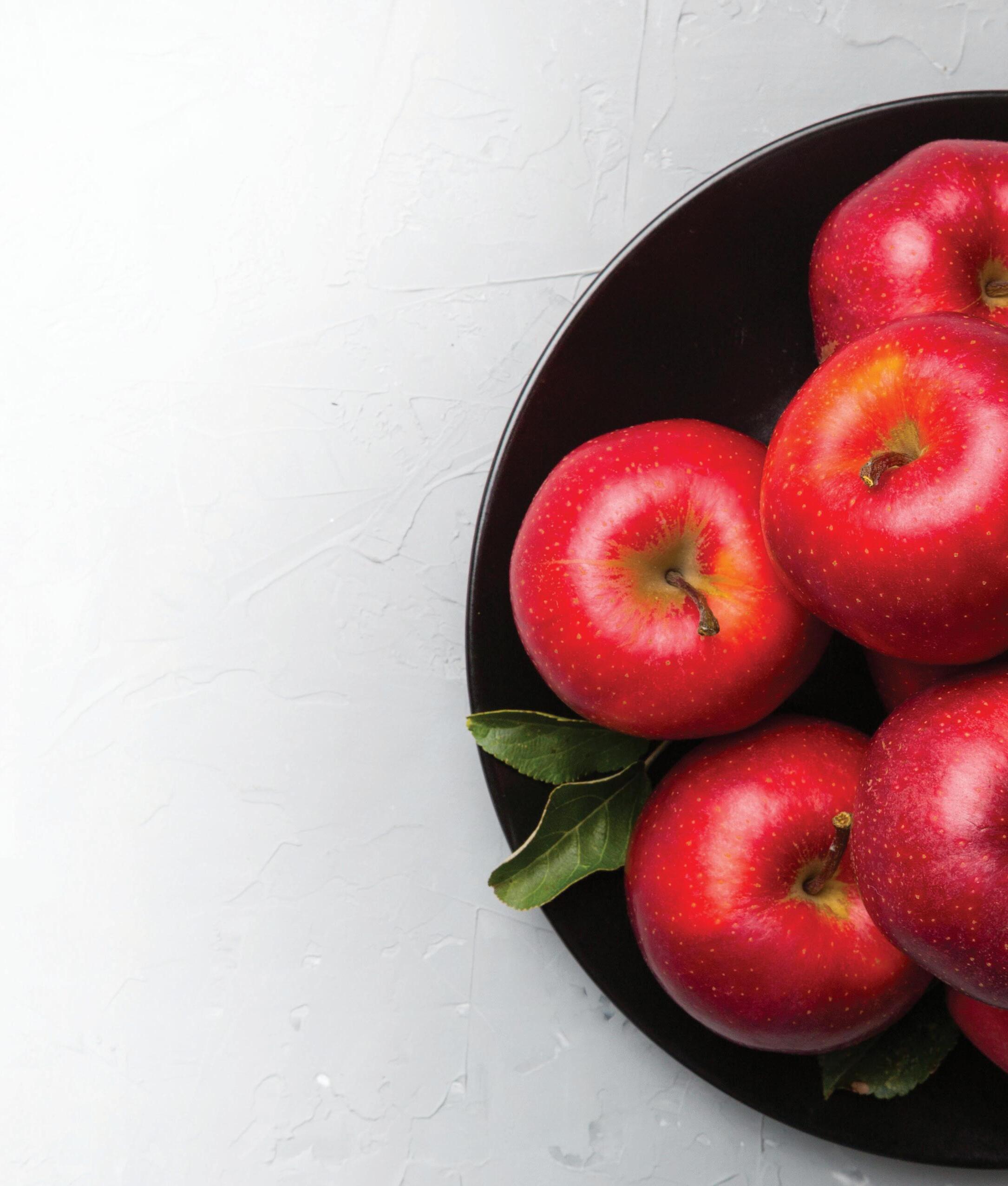
This apple is a cross between a Ben Davis and a McIntosh, first cultivated by Cornell University in 1898. Named after Cortland County, New York, these apples are sweet with a bit of a punch and strong enough to hold up well after slicing or baking. This is an easygoing apple, versatile (eat it fresh, baked, as sauce, etc.), and doesn’t require a lot of tending to grow.
This apple is straightforward and very sweet. It doesn’t have a thick skin and can be prone to bruising, so it prefers being handled with care. It can be used for all kinds of dishes and helps boost the sweetness profile of anything it’s mixed with, so it’s good to have around.
Named after Maria Ann Smith, this apple is uncompromisingly crisp with a tart taste, very refreshing and clear. It stands firm, holding true to its identity even when baked. Granny Smiths are patient apples, able to wait for long periods of time for their moment (up to six months in good conditions).
This apple is modern, designed carefully to meet many needs. Honeycrisps have a complexity of flavor that gives you both sides of the coin — sweet and tart. This apple loves the spotlight and built a name for itself by being willing to put itself out there.
Tami Arnowitz is a life coach, consultant and teacher with Good Questions Coaching & Teaching. She received her BA from Wellesley College and her MBA from Columbia Business School. Her Life Coach Certification was awarded by Life Coach Training Institute and she has also studied at Hebrew University and The Conservative Yeshiva in Jerusalem.


It may come as a surprise that the shofar won’t be heard at the start of the High Holidays this year. Since the first day of Rosh Hashanah falls on Shabbat, the shofar won’t be sounded. But why can’t the shofar be blown on Shabbat?
Because Shabbat is a day of rest, certain things are categorized as work. Even though the mitzvot of Rosh Hashanah (e.g., blowing the shofar) are important, even more important are the mitzvot of Shabbat. One of the 39 things that the Talmud says is forbidden on Shabbat is to carry (in this sense, taking things from inside and carrying them outside). For example, if you were going to blow the shofar for your congregation and you took the shofar from the shelf and carried it to the synagogue, that would violate the mitzvot of Shabbat.
If you were a skilled shofar blower, who had gone to, say, Ramsselaer Polytechnic Institute, you may think that you can just leave the shofar at synagogue and then there will be no outdoor carrying involved. However, the rabbis were worried that some people would forget, or some people wouldn’t know the rule at all. So they decided to make a blanket rule stating that nobody can blow the shofar on Shabbat.
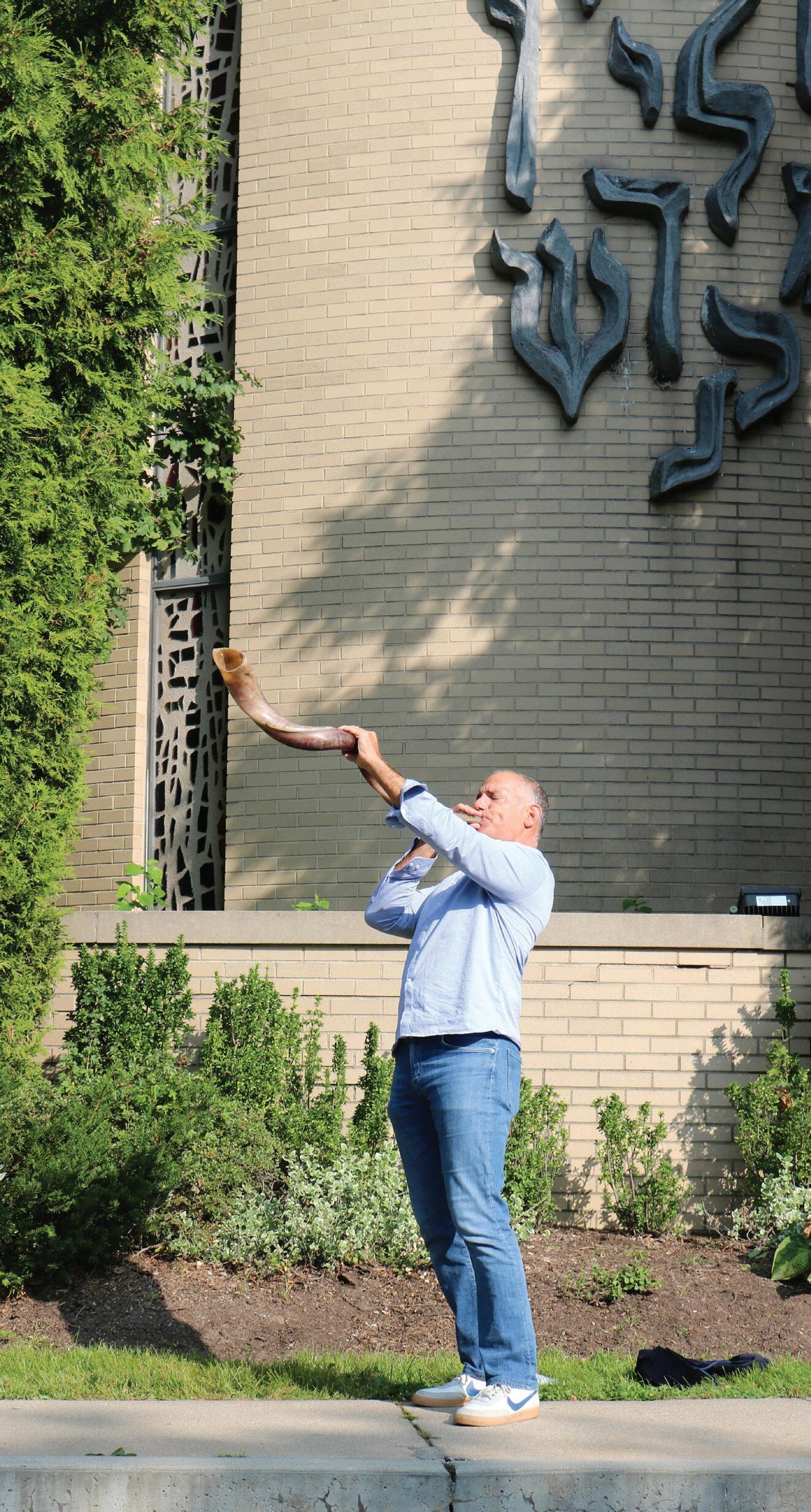
Rabbi Dalton doesn’t mind the lack of the shofar blast this year, and doesn’t see it as a tradition being broken. “I just think that it’s a different tradition this year,” she explains. “It happens once in a while. During COVID, we also didn’t blow the shofar, to keep people safe.” On the first day of the holiday, she says, “I hope everyone will be singing even louder to make up for the missed blast. I’ll also look closely for moments of silence and moments of singing, and those will resonate even more.”
For me, that initial shofar blast typically acts as a spiritual wake up call. This year, I’ll instead channel Shabbat’s peacefulness into a quieter, more personal shofar blast in my mind, which will make up for the one that we won’t hear blown.

As a teenager, I got very into the original stories by the Brothers Grimm. It was initially a bit of a surprise to realize that the “happy endings” were a lot more gory in the originals than in the Disney versions I knew. In fact, you might not even call them “happy” at all. As a fan of these stories and musicals, it’s no surprise that I also became a fan of Stephen Sondheim’s “Into the Woods.” Act I of “Into the Woods” follows the tales of the Brothers Grimm fairly closely to their endings, but then comes Sondheim’s master stroke — there is a second act. The journeys of the characters continue as each plot line goes sideways, tragedy strikes, new unions form, and the ending of the musical is hardly an ending at all. It is a much more ambivalent collection of the lessons learned as each character looks to an uncertain future.
That idea highlighted by Sondheim is actually a core idea of Judaism: it is not the end that matters as much as the journey. Endings are, in many ways, an illusion; the value and the lessons come from the journey itself. There is a special joy in recognizing you are on a journey. Even when the journey is sometimes challenging, or even painful, it is fortifying to know there is another turn, another chapter, another discovery to come.
It is also encouraging to know that we don’t have to travel alone. While my path may not be the same as yours, that doesn’t mean we cannot journey together. When we think of life as a grand trek, we don’t have to worry about having the same starting point or ending point; we can just
enjoy sharing the path we are on together. We don’t have to be concerned about who has more knowledge and who has less, who has experienced a place before and who has not. It is the diversity that makes the shared journey so enjoyable.
of the actual trips we take as a synagogue. Whether we are traveling to Israel, Eastern Europe, Morocco, or Alabama (all places to which we have either scheduled visits or have trips in the idea stage), the point is to relate to the location’s past, present, and future. We want to understand the journey of those who have lived in these places and how the journey itself incorporates learning into our own lives.
That is the doctrine I try to bring to synagogue life in both a philosophical way and a practical one. Philosophically, it is the diversity of our great WJC family that makes this place such a joy to serve. We have members from all different backgrounds and educations, who relate to their Jewish identity in so many different kinds of ways. The joy of this congregation is in the way we complement each other’s experiences as we walk our spiritual and personal path. The key isn’t that we take the same journey, only that we support each other in this particular moment on the trail. We recognize that we may not always walk the same path, and our paths might diverge along the way, but we can embrace this time while we do.
On the practical side, this is the purpose
For example, we are about to open registration for a Civil Rights tour in Alabama from Sunday, April 7, 2024 to Wednesday, April 10th. The trip will be to learn about the history of the Civil Rights Era in the South, to assess the present situation, and to inspire us for the future work still to be done. It is a natural part of the journey we have been taking as a congregation that has included mapping the history of slavery in Larchmont and Mamaroneck, learning about challenges for people of color in the housing market, and social action and learning programs for Dr. Martin Luther King, Jr. Weekend. We are not visiting to explore a moment in time or a thing that has ended, but to incorporate the journey of the place into our journey as a community. (If you are interested in traveling with us to any of the places listed, please let me know.)
There is great joy in journeying, and it is my privilege to walk this part of your spiritual journey with you. Few things bring me more joy.
“Into the woods it’s time to go I hate to leave I have to, though Into the woods, it’s time And so, I must begin my journey.”
— Stephen Sondheim, Into the WoodsRabbi Jeffrey Arnowitz became the Senior Rabbi of Westchester Jewish Center in August 2019.
One of our very own introduces WJC children to the music that shaped his own upbringing.
Matt Baum grew up in New Rochelle and has been a WJC member since the early ’90s, when his parents became members. For the past six years, he has taught music to the Kindergarteners through 4th graders as part of the Sunday morning WJC Religious School. His full time work is in event production as a Senior Manager of Product & Operations at HLTH, a platform that helps produce events for executives in health innovation and transformation. Matt currently lives in Mount Kisco with his wife, SK (Sarah Kay), and their one and a half-year-old Labradoodle named Charlie (a girl!).

Here are edited excerpts from our conversation:
ALISON CLARICK GOTTSEGEN: Hi Matt, it’s wonderful to meet you. When did you first become interested in music?
MATT BAUM: I started taking piano lessons while in elementary school, but my interest in music started well before then. My dad constantly played jazz around the house, and my mom still tells stories about how I used to carry around a toy guitar pretty much as soon as I could walk, refusing to go anywhere without it — she actually still has it to this day!
ACG: I love that! What kind of music do you like? Have your music interests changed over the years?
MB: I like jazz, funk, R&B, and pop mostly, but I listen to all different types of music. My taste and interest in music honestly hasn’t changed too much since I was younger!
ACG: Do you still play any instruments?
MB: I play guitar, saxophone and a little piano and drums.
ACG: Can you briefly describe your musical journey? Did you study music in college, play in a band, etc.?
MB: After taking piano lessons as a young kid, I picked up the saxophone in 4th grade. I immediately fell in love with it and
continued playing sax in school bands and jazz bands through college, where I received a BA in Music Performance with a Jazz Emphasis from the University of Connecticut. Along the way, while in high school and at sleepaway camp, I started teaching myself guitar, using my time as a camp counselor to refine my guitar playing, singing, and song-leading abilities.
ACG: You mention camp… Where did you attend camp, and did this experience in any way inspire your connection to Jewish music?
MB: I went to Cedar Lake, part of the New Jersey “Y” camps, as both a camper and counselor from the ages of 13 to 21, and being there really connected me to Jewish music. There’s nothing like taking part in a Friday night Shabbat service with 600 other kids at sunset overlooking the lake at camp. Eventually leading these
I absolutely love teaching [the students] the songs that I grew up loving. It’s a great feeling to hear the kids request their favorites and get excited when we play some of the ones that they’ve memorized and have come to love to sing.”
services really helped me understand how impactful Jewish music could be.
The other main driver of my connection to Jewish music was actually WJC! I spent my entire childhood coming to synagogue here. WJC is where I had my bar mitzvah, and I have tons of memories of the place and people, so being able to work here teaching music now is a really special experience for me.
ACG: Can you describe your work both teaching music at WJC’s Religious School, as well as with Rabbi Dalton at the family services for the High Holidays?
MB: As part of my regular Religious School work, I teach the students some of the music and prayers regularly sung at the synagogue, in addition to various other Jewish songs from my camp and around the world. I absolutely love teaching them the songs that I grew up loving. It’s a great feeling to hear the kids request their favorites and get excited when we play some of the ones that they’ve memorized and have come to love to sing.
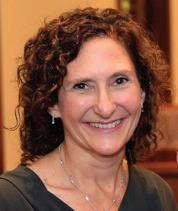
As for the family services, this will be the third year that Rabbi Dalton and I are working together. There are two Rosh Hashanah services—one on each day—and one on Yom Kippur. Each year, we spend a lot of time preparing guitar-led services that are primarily aimed at families, with the goal of checking off all of the boxes that the adults are looking for in High Holiday services, while still making them enjoyable and fun for their children! I’ll play guitar and sing, while Rabbi Dalton will also sing and lead us through the various ins and outs of the services.
ACG: Do you lead all of the “regular” service songs and nigguns, or do you also include other types of songs?
MB: We do most of the regular service songs, but also other
general Jewish songs, similar to the curriculum for the Hebrew School. This helps us achieve the goal of meeting the adults’ needs for the service, but also engaging their kids with songs that are accessible that they may have already been hearing and learning in Hebrew School.
ACG: In closing, can you describe a time that music brought you total joy? Perhaps this was a time when the music did not have anything to do with teaching, but rather a time you just experienced the utter joy of it.
MB: Most of the moments in which music has brought me joy have been while seeing live music. After graduating from UConn, I worked for about three years helping to book the music at a jazz club in Manhattan (Jazz Standard, which unfortunately closed due to COVID-19) and seeing incredible musicians such as Christian McBride, Cécile McLorin Salvant, Esperanza Spalding, Maria Schneider, and various other unbelievable artists playing to 130 people packed into a small room is truly an incredible experience. There’s nothing like it.
ACG: I hear you! Thanks so much for your time, Matt — the children and families are lucky to experience your music at WJC!
Alison Clarick Gottsegen has been a Museum Educator for 27 years at a variety of museums. She chairs WJC’s Musical Enrichment Committee and enjoys spending family time in NYC and the great outdoors.
Discover exciting educational methods to captivate young minds and introduce them to the delight of the holiday season.
The High Holidays are approaching and, with them, the annual question: How do I get my kids engaged in the holidays? Benjamin Franklin once said, “Tell me and I forget, teach me and I remember, involve me and I learn.” Involvement is key. By making kids familiar with the High Holidays and their traditions beforehand, it can help them stay excited and involved throughout the holidays. So what kind of activities can you do with your child leading up to the holidays to nurture their enthusiasm?
Make Shanah Tovah cards with your children. These can be for members
strangers. Residents of senior living facilities love receiving cards for the holidays. While making cards, you can discuss the months in the Hebrew calendar or compare your Rosh Hashanah traditions to your secular new year activities.
We love to decorate the house for the holidays. You can make pomegranate chains, apples and honey pottery plates, sukkahs out of popsicle sticks, etc. The possibilities are endless. The important part is to discuss the meaning behind what you’re making.

3.
If you’re anything like the kids in my family, you think with your stomach. Okay, let’s be honest, it’s not just the kids. We make the same family recipes every year and the kids love this tradition. While making honey cookies and apple cake, we talk all about the tradition of dipping apples in honey and discuss all of our wishes for a sweet new year. Here is our favorite Rosh Hashanah Recipe!
2 1/4 cup flour
1/4 tsp. ginger
1/4 tsp. cinnamon
1/8 tsp. cloves
1/4 tsp. nutmeg
2 tsp. baking soda
1 egg
1 cup sugar
2/3 cup oil
1/4 cup honey
DIRECTIONS:
1) Combine flour, baking soda, and spices.
2) Beat oil and sugar.
3) Add egg and beat well.
4) Add honey and flour just until mixed.
5) Roll into walnut sized balls.
6) Roll in sugar.
7) Put on cookie sheets with parchment.

8) Bake at 350º for 12-15 minutes.
We like to listen to songs about the holidays as much as possible leading up to them. Spotify has a surprisingly large array of Hebrew songs and many curated playlists for every holiday. Have songs playing in the background while you bake together, on car rides, or while playing a game. Eventually, you’ll be able to sing along! If you specifically want your children to learn the prayers for the High Holidays, they can, among other places, be found on the WJC SoundCloud page: https://soundcloud.com/user-235388266 YouTube has so much valuable content if you have the time to sift through it. Depending on the ages of your children, different videos will appeal to them but there is something for everyone. It is important to preview these videos for accuracy and appropriateness. In our house, any video with actress Mayim Bialik is a favorite. Her videos are full of interesting information. And we also love the Maccabeats, a Jewish band which creates fun and engaging a capella Jewish-themed music.
PJ Library is always a great resource for getting books about Jewish holidays. So is our synagogue library! Never underestimate how much kids love being read to, regardless of their age.

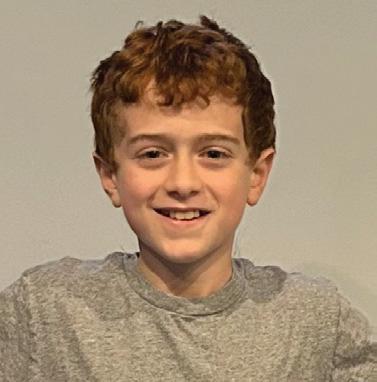
Discuss with your children the meaning of repentance. What kinds of things should you be apologizing for? What makes an apology sincere? You can help your children make a list of those to whom they would like to apologize. You can also have them brainstorm a list of resolutions for the coming year. Discussing the things that we repent for helps kids have some direction in their self-prayer during the holidays.
Let your kids show off all their new knowledge. Let them share their artwork, ask them questions in front of family members about the new things they’ve learned, or have them do a performance of holiday songs.
I am hopeful that these suggestions will help build excitement in your children for the upcoming holidays and help to create a meaningful and sweet new year. Shanah Tovah!

Joanna Shlesinger teaches Kitah Alef at the WJC Religious School. She previously taught third grade at a Jewish Day School in Boston. She and her husband, Yaron, and children, Joshua (11), Adam (9) and Leora (6), are members of WJC.

In the spirit of this year’s High Holiday theme, “Joyful Together,” we asked congregants to identify a moment they felt most connected and happy in synagogue.
—Sherry ThalerSince joining WJC in 1963, I’ve had many joyous moments in synagogue, including my daughters’ b’not mitzvah and chuppahs. What I’d like to convey is the happiness and sense of accomplishment that I’ve experienced each time I come up to the bimah to chant haftorah or Torah at WJC or family members’ synagogues.
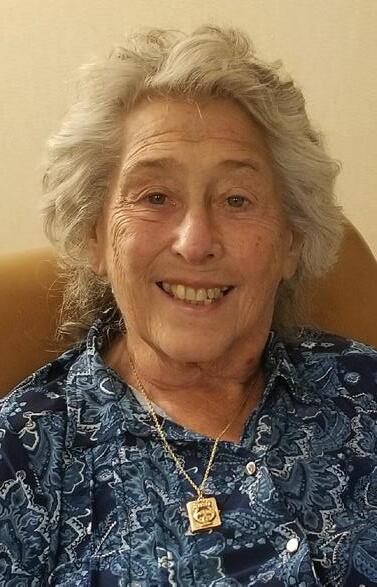
I was privileged to be part of the first adult bat mitzvah group at WJC in 1984 where we learned and divided the haftorah and blessings between 16 women but were not permitted to read from the Torah. Following that, I chanted the haftorah solo at WJC. This gave me the courage to learn to chant from the Torah once women were allowed. I’m not very musical, making trope learning extra challenging. Working hard to learn each Torah portion gives me an incredible sense of accomplishment. Seeing the faces of my family as I chanted Torah at the b’nai mitzvah of my grandchildren has been extra rewarding and I hope will inspire them and their families to continue their Jewish education and commitment to their communities.
My happiest synagogue memory was the day I walked into Kiddush and there was French toast with chocolate chips. It was delicious and now I look forward to Kiddush every week.
I had a lot of fun at Youth services this year when the leader brought in Froot Loops and jellybeans and used them to teach us all about the different tribes of Israel.
Meeting new people and making friends is my favorite part of coming to WJC. I’ve made my best friends at the ECC, Shabbat, and holiday services. Recently, my mom introduced me to a girl with the same name as me!
Our synagogue president reflects on his enriching experience traveling America alongside fellow Jewish teens.
Iwas all of sixteen years old and spending my first solotravel adventure with USY on Wheels. It was a six-week tour exploring the US in one of 18 or so charter buses criss-crossing the country. Although I knew no one on my bus when we left New York, my experience traveling with fellow teenagers during a celebratory year was a foundational experience for me. We were staffed with four adults who managed to supervise all 40 of us, as we visited 26 cities and traveled more than 6,000 miles. We became a close-knit group and made up some amazingly funny songs (“We all live on a Walter’s-Transit bus…,” “Deck the halls with lots ’a matzah,” and more) during the long voyages between cities. We played cards, shared stories, and kept journals. From time to time we would connect with another USY bus and share a meal or a Shabbat celebration together.

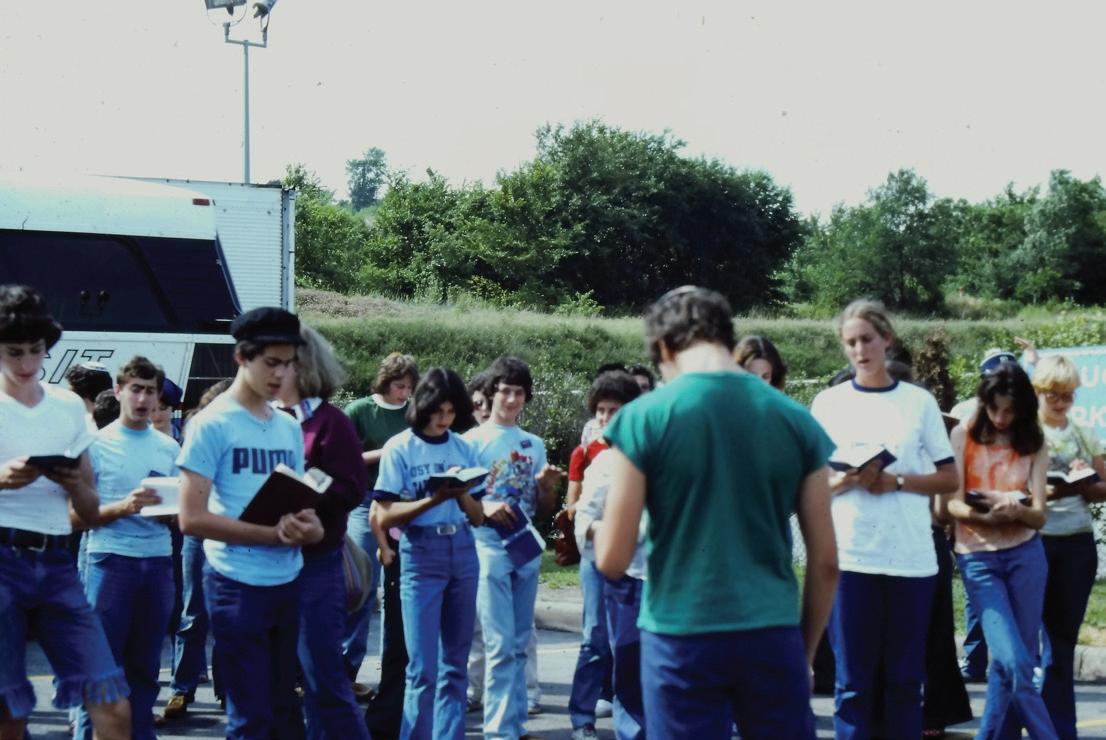
Throughout the country, there were festivals almost everywhere we visited — from marching bands to parades, people in revolutionary costumes, and even some dancing in the streets. Everything was decorated in red, white, and blue. The US was 200 years old! People from all walks of life found reason to celebrate together and explore our amazing history.
As a group, we teens were responsible not only for staging our own meals, but also for leading daily and Shabbat prayers. One of my favorite elements of the trip was the beautiful melodies and ruach (spirit) we put into each prayer, singing nearly every one. If you’ve had a chance to hear me lead services in the present day, I
sometimes try to bring back some of those tunes; those melodies still help drive my personal spirituality when I am davening.
After all these years I still remember many of the trip’s highlights: We visited the Indianapolis Motor Speedway, home of the Indy 500 (I am a car buff) and saw so many generations of the fastest cars on earth.
We went to the gateway arch in St Louis, Missouri, where I met a young lady from Lincoln, Nebraska, who would become my pen pal for several years.
We went to Pikes Peak in Colorado, where the air was so thin I could barely breathe, nevermind stand up. But when I finally did, the view and our prayers were beyond anything I had ever seen before.
I can still picture the majesty of the Grand Canyon, waking as a group at dawn to descend the steep slopes, and, of course, singing the whole way, despite the hour.
We spent Shabbat in San Diego, then crossed the border to Tijuana for my first time out of the country.
And, finally, we connected with all 18 buses in Washington, DC, for our final banquet celebration at the end of the journey. Imagine more than 700 teenagers at one big blow-out party with a live band, dancing, and singing in our nation’s capital.
Music played an important role in generating joy for me that summer. Here at WJC, I know that our clergy has spent the past six months remaking our High Holiday experience for this coming year, adding musical family services, congregational
singing, and more opportunities for participation. I hope that some of the joy I felt on my trip forty-seven years ago can be felt inside our halls at WJC.

It is my wish, and the fervent hope of all leaders of WJC that this coming year 5784 brings health and happiness to you and your families. L’Shana Tova Tikatevu. May all our congregants and their families be written for good in the book of remembrance.
Larry Thaler is a media technology executive, honored by the industry, with four Emmy awards for innovation, who is currently CEO of the VCC. He and his wife, Sherry, joined WJC in 1994 and enjoyed watching their daughters, Ali and Cam, grow up surrounded by the community. Larry feels indebted to all the leaders and volunteers of WJC and looks forward to working with and getting to know everyone during his tenure as President.
In the spirit of this year’s High Holiday theme, “Joyful Together,” we asked congregants to identify a moment they felt most connected and happy in synagogue.
—Sherry Thaler Bill Natbony
Lights, camera, action! My happiest synagogue moment happens annually. It is a time of singing, dancing, laughing, celebrating our Jewish heritage, and spending time with friends and family—and even includes a little nosh for good measure. You guessed it, it’s the Purimshpiel. What an amazing evening each year. On what other day can I tap dance, square dance, sing Broadway melodies (with Purim-related lyrics by our own Randy Heller), shoot off a confetti cannon, and return to my childhood acting days? A fun experience not just for me, but the audience as well — with their laughter and support making it that much more rewarding. I can’t wait to start preparations for 2024!


Our gallery curator explores the latest exhibit featuring the art of Broadway caricature.
The Koslowe Gallery is overjoyed to invite our members and friends to experience the art of Broadway caricature through the eyes and the pen of Al Hirschfeld. We have assembled theater works from nearly every decade of his career, sketchbooks that reveal his first impressions and ideas for capturing his subjects, and a few surprises.
Even as Hirschfeld’s work was replete with drawings of Jewish contributors to American culture, it was an accident of the world in which he tread. “While Al Hirschfeld did not look at himself as a Jewish artist,” said David Leopold, the director of the Al Hirschfeld Foundation, “he was a great supporter of Israel.” Our show features unpublished works that Hirschfeld created on 1953
a trip to Israel. He had been commissioned by LIFE magazine to illustrate his own written narrative of his tour of the new country. The story never ran. We are pleased to have the privilege of showing the drawings for the first time.
We have chosen this show as a display of work that came from the sensibility of a Jewish man, born in 1903, who lived the 20th century from beginning to end. It was a period of great consequence to the Jewish people. Hirschfeld engaged in chronicling the particular traits of the century’s stars, many of whom Jewish, who brought the characters and music of the Great White Way to life. A self-described “characterist,” Hirschfeld’s linear calligraphic style appeared in nearly every major publication over the last ninety years (including a 75-year
1989
Koslowe Gallery program and reception will be held on Wednesday, November 1, at 7:45pm.
We are thrilled that David Leopold, Creative Director of the Al Hirschfeld Foundation, will join us this evening to speak. David Leopold is an author and curator who has organized exhibitions for institutions around the country including the Library of Congress, the New York Public Library for the Performing Arts, the Norman Rockwell Museum at Stockbridge, the James A. Michener Art Museum, and the Field Museum in Chicago. He organized the archive of Al Hirschfeld’s work for the artist, and is now the Creative Director for the Al Hirschfeld Foundation, where he cohosts The Hirschfeld Century Podcast. His 2015 book, The Hirschfeld Century: A Portrait of the Artist and His Age, coincided with a major retrospective that Leopold curated for the New York Historical Society has won universal acclaim.
relationship with The New York Times), as well as numerous book and record covers, posters, advertisements, and on 15 postage stamps.
Through his years of producing line drawings that captured the essence—both the idiosyncrasies and the charms—of the movers and shakers of the Broadway scene, Hirschfeld gave the public the opportunity to feel like they had an intimacy with Broadway even if they hadn’t had the chance to see the artists perform. Many children of his time grew up counting the number of times they could find Hirschfeld’s daughter’s name, Nina, hidden within each drawing.

His works gave the shows that he studied a rousing sendoff through their uncanny likeness to his subject. “Hirschfeld’s audience had a sense that they were laughing along with these actors and artists, not at them,” said Leopold. This trust between artist and subject built enormous interest and support for Hirschfeld, who made line-drawing of these creative individuals an art form, coveted to this day, by his audience and his subjects alike. Capturing the essence of a singing, dancing, twirling, orating performer required enormous technique. “Hirschfeld was known for making that skill look like a gesture of ease,” said Leopold.
Hirschfeld produced his first theater drawing in 1926. Still sitting in the theater, he doodled the likeness of French actor Sacha Guitry’s Broadway debut on the back of his program. A week later The New York Herald Tribune published it. Fast forward to June 2003, the year he died at age 100, when he was given the highest honor among his peers. The Martin Beck Theater was renamed the Al Hirschfeld Theater.
His work has rightly been called the logo of the American Theater.

Finding joy in your life involves embracing the present, cultivating gratitude, and nurturing connections that bring warmth to your heart.
Joy is a fundamental aspect of Jewish spirituality. And while there are many Hebrew words that roughly signify “joy”, the one most often heard is “simcha,” which can be understood not as an ephemeral feeling of happiness, but rather a state of being that permeates one’s relationship with oneself, others, and the Divine.
In the story from the Talmud (Taanit 22a) featuring Rabbi Beroka Hoza’a and Elijah the Prophet, we encounter a profound lesson about the nature of joy and its significance in the pursuit of righteousness. Rabbi Beroka, seeking to identify individuals worthy of the Worldto-Come, turns to Elijah for guidance. He assumes that those engaged in religious or scholarly pursuits would be the most likely candidates. However, Elijah reveals a different perspective by pointing out two seemingly ordinary men, jesters, who possess a share in the World-to-Come.
This story challenges our preconceived notions of what it means to attain spiritual merit. The jesters, though engaged in an occupation not traditionally associated with religious piety, demonstrate qualities that garner them a revered status in the eyes of Elijah the Prophet. They bring joy to others and work to mend conflicts, actively contributing to the well-being of those
around them. That is joy, deep, real joy. That is a taste of the World to Come.
Additionally, this tale suggests the transformative power of joy to transcend one’s personal experience into an outward expression that impacts the lives of others. The jesters, through their ability to uplift and console, fulfill an essential role in society. By choosing to engage in acts of kindness, they create a positive atmosphere and contribute to the healing of broken relationships. In other words, a profound and healing experience of joy.
Let us reflect on the sources of joy in our own lives, and seek out moments of connection, compassion, and reconciliation. By nurturing simcha in our own lives, may we find bring joy to those around us, and in doing so, contribute to a more harmonious and fulfilling existence both in this world and in the World to Come.
—Rabbi Menachem Creditor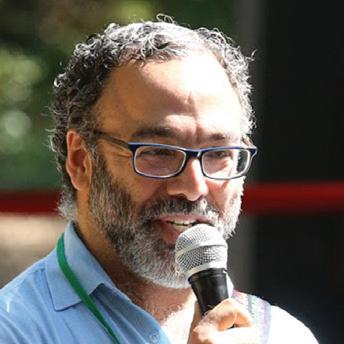

When we think about what we want for ourselves and those we love, the answer is often happiness. Ironically, our endless pursuit of happiness often results in unhappiness. This may be because we are searching for the wrong thing and looking for it in the wrong places. My mindfulness practice has helped me find incredible joy in the most surprising places. Below are some steps inspired by what I have learned. I hope they will help you find greater joy in the New Year, starting right now.
STEP ONE: Accept the truth that we are not always supposed to be happy. Being human means feeling all sorts of feelings. Yet our culture pushes the belief that if you are unhappy, something must be wrong with you or the world around you. The refusal to accept unpleasant emotions as normal throws us into an endless cycle of always trying to fix or solve perceived problems so that we can then be happy. If we wait for all of our problems to be solved in order to be happy, we will be waiting a very long time. The key to beginning your search for happiness is to give yourself permission to accept and experience all of your emotions as they come and go.
STEP TWO: Check where it is you are looking for happiness. We often look in all the wrong places. We look for happiness in the achievement of goals, like a promotion at work, buying a new home, or a long-awaited vacation. Or, we look to our relationships (and other people) to make us happy. When we do, our happiness is conditional and dependent, outside of our control, and often one step out of reach. The best place to find true happiness is within yourself, and the best time to find it is right now. You don’t have to accomplish something new to find it.
STEP THREE: Better understand what it is you are searching for. So far, I have used the word happiness to describe what we seek. However, happiness usually involves the self and the accomplishment of a goal — resulting in a feeling of happiness. We find, however, that this feeling is short-lived, and we quickly begin looking for the next thing to achieve, accomplish, or acquire in order to feel it again. I prefer to think of joy as what we are seeking. Joy is long-lasting and deeply felt. Joy comes from
A joyful poem by Gali
LodishA beautiful custom in the Jewish tradition
To awaken and give gratitude
To reflect on how the soul has been returned to the body
feelings of gratitude, love, and contentment. It is not dependent on some event or circumstance but results from an appreciation of what you already have. Instead of looking to find happiness one day in the future, you can feel joy right now.
STEP FOUR: Find joy in your life every day. This is surprisingly simple, costs nothing, and can be done anytime or anywhere. The only place to find joy is in the present moment. Yet our minds are constantly in motion, thinking about the future or stuck in the past. Research shows that a wandering mind is an unhappy mind. So, start by pausing throughout your day and bringing your attention into the present moment, where your life is actually happening. Then, notice what is here right now. You will find that there is always something to appreciate, savor and be grateful for in the present moment. Don’t look for extraordinary things. Instead, notice the simple things we too often overlook, take for granted, or are too busy to notice. These are the things that can bring you deep and lasting joy—the food you eat, the breath in your body, the clean water you drink, the friends and relatives who love you, the sunshine on your skin, or the blue sky above, to name just a few. Feel all of the feelings of joy, appreciation, and gratitude in every cell of your body. We are very good at feeling difficult emotions, but we rarely pause to feel all those good feelings. So, pause throughout your day, be present in the moment to notice all you have right now, and feel the joy in that.
Don’t wait to find joy. Learn to make your every day extraordinary by finding all the joy right here waiting for you!
—Cheryl BrauseAfter a night of sleep — From where has it returned While in slumber does it travel to other realms
To the subconscious we know it does
Traversing the circuits of the brain’s sulci
Making stops and uncovering paths that are left unexplored in the light of day
But in slumber, while the eyes are moving rapidly, the mind is on a trip
Into its own hidden desires
Unprocessed thoughts and feelings
And then we wake up and are back here
And give thanks
For the miracle that is life.
For many years, I was the food drive coordinator for the Larchmont/Mamaroneck Food Pantry. It was there that my love for volunteering and providing food for those in need grew. Whenever a group wanted to organize a drive, I collected the food and arranged for volunteers to sort through the donations. Often, school groups would help and families would stop by when they were celebrating birthdays or milestones. They would all lend their hands and time, recognizing how important it is to give back. They came in with big smiles on their faces and with a sense of pride knowing that they were helping such a good cause.
When I joined SOJAC (Social Justice and Action Committee) at Westchester Jewish Center, I hoped that I could continue my work providing food for those in need. Over the past number

of years, we have mobilized collections for many individuals and organizations. Most of the time, those who receive our generosity do not know the source. The gift of giving anonymously is truly a blessing. Likewise, those volunteering do not know the individual recipients. This is tzedakah in its purest form and provides pure joy for those helping.
Nothing was more challenging than what the pandemic brought. As the need for food stability increased in Westchester, not to mention throughout the country, we were faced with figuring out how to provide assistance without gathering. Fortunately for our larger community, HOPE Community Services didn’t miss a beat. As one of Westchester’s largest food pantries, HOPE continued to provide their critical services and food. They continued to look to WJC, and to all of its partners, for support. Our solution for helping during this uncertain time? We had members cook at home. We then delivered meals to HOPE, where people would line up outdoors to receive their food. This project has been ongoing and has made our WJC chefs and the HOPE clients extremely happy. For all those involved in helping and receiving, it has brought immense joy.
—Sondra Levy
As I stood in the doorway of my childhood home, boxes stacked around me, I was enveloped by a mixture of nostalgia and melancholy. The time had come to pack up my parents’ home, a place that held decades of memories and stories, deciding what to keep, what to donate, and what to discard. As I continued packing, I came across a treasure trove of items from my preschool days spent at my childhood temple.
I stumbled upon a well-loved menorah, its vibrant colors, bolts and screws buried beneath years of candle wax. The memories it held rose right to the surface of winter nights in our kitchen lighting the candles, and of the laughter and anticipation as my family gathered together for those eight special nights. I uncovered a handmade matzah cover—a masterpiece crafted by my toddler hands with markers, glue, and sequins. I was transported back to the seders of my childhood—rearranging of the living room furniture to accommodate our extended family, the scents of parsley and charoset wafting from the kitchen, and the warmth of family packing tightly around our Passover table. Holding these relics of
my childhood in my hands, I felt the weight of tradition, and the joy of those fleeting moments as a child in our young family.
Amidst the hustle and bustle of packing up my parents’ home, an unexpected emotion began to emerge: joy. Little did I know that decades later, my daughter, now attending WJC’s ECC preschool, would be creating similar works in her classroom. My heart filled with joy as I thought about my daughter’s preschool experience: the classroom adorned with colorful drawings and crafts, the class placemat that sits on my kitchen table, and all the Jewish holiday arts that we’ve started to put to use in our family celebrations. I smiled as I compared the two sets of memorabilia—one from my past and one from my present—recognizing the continuity of tradition in the simplest of ways.
As we enter into the High Holidays, I am acutely aware of the preschool memorabilia that shaped my childhood and is now shaping my daughter’s. I look forward to putting her holiday learnings and crafts in the center of our family traditions and making memories that will serve her—and my whole family—a lifetime. Packing up my parents’ home was a bittersweet task, but it also offered a profound lesson in the power of tradition and the enduring impact it has on my own parenting style.
—Tracey KantrowitzLighting candles on shabbat. Holiday meals with family. Building a sukkah in our backyard. Filling up the tzedakah box with dollar bills and loose change. Throwing bread into the water at tashlich to cast away our sins.
Passing on these Jewish traditions to our two children, Noah and Nellie, is a profoundly meaningful and joyous experience. As parents, we become the custodians of a generational legacy. Sharing these traditions with our kids fills us with nachas.

At the heart of this joy lies the sense of connecting with something greater than ourselves. Jewish traditions are a link to our ancestors, who faced challenges and celebrated triumphs. Each experience adds to the vibrant mosaic of our identity. When we pass on these traditions, we bridge the gap between the past, present, and future, building a sense of continuity that instills in our children a deep-rooted sense of belonging to our rich tradition.
Passing on Jewish traditions also offers the joy of discovery. As we explain the meanings and stories behind each ritual, we see the spark of curiosity in our children’s eyes. Questions arise, discussions unfold, and in the process, we find ourselves renewing our own understanding and connection to these customs. It’s a journey of continuous learning that keeps both the past and the present alive and relevant. L’Dor V’Dor.
—The Wasserman FamilyTuesday, September 28, 2021:
When my cell phone buzzed at 6:30 am, I knew it wasn’t good. “Dad died,” my sister said in a voice that was partly matter-offact, and partly in disbelief. Yes, Dad had been going downhill, but it had been a very slow, albeit painful, process. Nothing had happened in the previous few days that gave us any indication that the end was coming.
Today was Shemini Atzeret, the beginning of the final two-day fall Holiday period, which meant that I walked from my house to the Hebrew Home, where Dad had been living for the past two years. When I got to Dad’s room, one of the nurses greeted me tearfully. “He had some juice at 5:00, and then when I came back to check him, he was gone,” she said. And then the nurse was gone, as she needed to tend to the other residents on the floor.

Dad lay in his bed. His eyes were closed and his mouth was open. For some reason, I needed to determine for myself that he was really gone. I gently put my hand on his forehead, which was cool. I looked at him for at least one minute, wondering if the nurse had gotten it wrong and that he would all of a sudden open his eyes and ask me what I was doing there.
After that one minute, I was convinced. He really was gone. And so I sat down beside him, just the two of us. Neither of us was in a particular hurry.
I slowed my breath and noticed the many thoughts that raced through my brain. “I need to let the Rabbi know.” “We need to cancel the guests who are coming for lunch today!” “Barbara and I need to figure out how to get Dad to Florida!”
Then I closed my eyes and breathed, for what was likely ten minutes. When I opened my eyes, Dad was still there. Still gone. And I felt better. I felt calmer, and I felt something that I did not expect—joy. What was the joy of being able to be with my father, just the two of us, having “quality time?” Perhaps it was no coincidence that today was Shemini Atzeret, the day after Sukkot, the day that God commanded for no other reason than just to be alone with the children of Israel, with no guests.
After two hours, the nurse came back with an attendant, as we needed to move Dad from his room to the space where bodies are stored prior to being moved to the funeral home. Now it wasn’t just the two of us, but I didn’t care. I had my final time with my father, a time that I will carry with me for the rest of my life and which will give me strength.
—David GoldsteinAs a member of WJC (and especially of the Sisterhood), I feel fortunate to have found a spirit of community that is very heartwarming.
When I first came to WJC to say Kaddish for my late husband, I knew no one and was not even a member. Rabbi Segelman went out of his way to ensure that I had a proper minyan. It meant a great deal to me to be welcomed into a place where I knew no one. There’s an unexpected bonus that occurs when one is so warmly welcomed in a place of the soul. Because of this, I now am a regular at minyan, hoping to repay the kindness. There are ancillary benefits that have accrued to me. I’ve gotten to know some really great people (especially Cheryl N. and Jerry N.—our minyan shepherds), along with the “regulars.”
On the lighter side, through the auspices of Sisterhood and its creative and gracious leaders, we had experiences that were informative, meaningful and joyful. Most recently, there was a henna party that was loads of fun.
At the end of April, I lost my dear and only sister. The outpouring of the minyan group, along with many other members, including our president Larry Thaler and his wife Sherri, were at my home, ably led by Rabbi Arnowitz and Rabbi Dalton. It left me speechless and grateful. It is truly an honor to be connected to WJC.
—Marcia JaegerRABBI MENACHEM CREDITOR serves as the Pearl and Ira Meyer Scholar in Residence at UJA-Federation New York. An acclaimed author, scholar, and speaker with over 1 million views of his online videos and essays, he was named by Newsweek as one of the fifty most influential rabbis in America.
CHERYL VIGDER BRAUSE, a member of WJC since 1999, is the co-founder of Pause to be Present, a Virtual Meditation Studio, and 2bpresent, a website about mindful living. Cheryl now writes and teaches about the transformative practice of mindfulness meditation.
GALYA “GALI”
SHALIT LODISH is a mother and an Internal Medicine physician, who enjoys writing poems in her free time. She lives in Larchmont with her husband and two sons, and is a member of Sisterhood.

SONDRA LEVY joined WJC in 1999. In addition to volunteering (and encouraging other WJC members to join SOJAC), her greatest joy is her new granddaughter!
TRACEY KANTROWITZ and family joined WJC in 2022. She can’t wait to replace all her handmade preschool judaica with pieces made by her children.

MARCIA JAEGER was born and raised on New York’s lower East Side. She is a graduate of New Jersey City University, where she earned a B.A. in Art & Education, and worked as an art teacher and a fabric designer. She feels very fortunate to have two great sons and four grandsons.

Bereshit bara Elohim et hashamayim ve’et ha’aretz.
Our very Torah, the pillar of our tradition, begins with the radical amazement of God’s creation of heaven and earth. And that sense of wonderment remains with me, through all generations of human beings, since Adam, when we were declared stewards of the earth. I am in awe of the way in which my mind, soul, and body feel both grounded and uplifted every time I delve into nature. Whether through a meandering trail of wildflowers, a pathway in a pine-filled forest, or immersing into a lake, I find my joy in nature. There is always something special to see: The orange blossom of jewel weed, fireflies alighting, great blue herons soaring. It’s the whimsy of the unpredictable married to the calming stability of nature carrying onwards that makes me feel at peace and deeply happy to be a part of it all.
REBECCA AND GABRIEL WASSSERMAN joined WJC in 2019. They are proud that their children began their Jewish journey in the ECC and continue learning at WJC’s Religious School in Kitah Bet and Kitah Gimel.

A Westchester County native, DAVID GOLDSTEIN is WJC’s Executive Director. Previously, David served in a variety of roles in the Jewish Community, most recently as the Assistant Executive Director of the Barry & Florence Friedberg Jewish Community Center in Oceanside. David and his wife Melissa Braverman live in Riverdale and are the proud parents of two daughters: Ranya (18) and Adiella (12).
GLENNA LEE loves being in the kitchen, particularly alongside her daughters who cook much better than she does. Glenna is proud to have been raised at WJC and serve as the President of the WJC Sisterhood alongside women she has admired throughout her life.
—Glenna LeeWHETHER OR NOT WJC SHOULD ADD A HEBREW NAME.
When a member of our congregation is called to the bimah for an aliyah, the Rabbi or Cantor always asks for some personal information: our Hebrew name. Mine is Avrum ben Beryl, in honor of my father Bernard. It’s always moving to hear it incorporated into the blessing calling me “up.”
It’s likely that every member of the congregation has a Hebrew name. But the congregation as a whole does not: we are the Westchester Jewish Center. We do not have a formal name such as Congregation (fill in the blank). We all know synagogues that have Hebrew names, such as Beth Elohim, or Etz Hayim, or Keneseth Israel. The listing of US synagogue names is a long one—more than 3,000—but it is rare for one not to have a Hebrew name. Each such name, of course, has a literal meaning. Beth

Shalom, or House of Peace, Anchorage, Alaska. Congregation Emanu-El, or God is With Us, San Francisco. Or, chillingly, Congregation Etz Chaim, Pittsburgh, the Tree of Life that was horribly visited by gun violence that brought death. Many names are commonly used. There are at least 14 congregations known as Adas Israel, or simply Congregation of Israel.
This all suggests two obvious questions: Why does Westchester Jewish Center not have a Hebrew name? Might we add one?
To answer the first question, it’s important to understand that the term “Jewish Center” has its own special history—one based very much in the New York City area and even more specifically in Brooklyn. Both the name and the idea of a “Jewish Center” are aspects of American Jewish history—reflecting the complexity of sustaining both Judaism and “Jewishness” as American Jews left immigrant ghettos and became both wealthier and more secular.
It’s a story well told in David Kaufman’s scholarly account, “Shul with a Pool: The Synagogue-Center in American Jewish History” (Brandeis University Press, 1999). Kaufman recounts the emergence in the 1920s of a new type of Jewish institution, one that would combine prayer, study, and social assembly/ recreation. It was to serve as a “means to ‘sell the masses’ on synagogue membership and, even more critically to ‘lure’ straying youth back into the fold of the Jewish community.”
The Center movement drew on—and contrasted with— influences dating to the 19th century. The classical Reform movement had offered more accessible observance, including mixed-gender seating, English liturgy, and enthusiasm for the sort of social cause idealism of 19th-century American “social gospel” Protestantism, as expressed in church-like sermons. It held somewhat limited appeal, however, for the more observant Eastern European immigrants who followed in the immigrant footsteps of German Jews who had brought the Reform movement with them.

For these newer immigrants, there emerged the Jewish
Community Center, a Jewish analog to the YMCA (Young Men’s Christian Association). The YMHA (H for Hebrew), as well as the many Jewish Community Centers which followed, would provide a place for Jews to gather comfortably for clubs and recreation— but not prayer.
The Jewish Center movement would emerge as an effort to offer some of the recreational elements of the Community Center without foregoing prayer. It would bring together three elements or “houses”: the beit-tefillah (house of prayer); beit-midrash (house of study); and beit-knesset (house of assembly). The sanctuary and ark would be complemented by gyms, libraries, social halls, sisterhoods, and brotherhoods—and, yes, swimming pools. If it had one key intellectual leader it was Rabbi Israel H. Levinthal, who built and led the congregation which became the flagship of the Center movement, the Brooklyn Jewish Center in Crown Heights.
“If the Synagogue has lost its hold upon the masses,” he said in 1936, “some institution would have to be created that would attract the people so that the group consciousness of the Jew might be maintained. The name Center seems to work this magic with thousands who would not be attracted to the place if we simply called it Synagogue or Temple.”
The term Center was what we’d now call branding, if you will— and it worked and spread. In 1940, there were more than one million Jews in Brooklyn—and 20 “synagogue-centers.” They were notably Zionist, in contrast to the anti-Zionist classical Reform movement, whose American Council for Judaism distinguished between Judaism as a religion and Jews as a people. The Centers notably featured what Kaufman calls the “star cantor” —Richard Tucker was the Brooklyn Jewish Center cantor until moving to the Metropolitan Opera!
Many Centers from the period still exist, including the Flatbush Jewish Center and the Ocean Parkway Jewish Center. At the time Kaufman wrote (1998), he counted 33 such Centers in Brooklyn.
If the Synagogue has lost its hold upon the masses, some institution would have to be created that would attract the people so that the group consciousness of the Jew might be maintained. The name Center seems to work this magic with thousands who would not be attracted to the place if we simply called it Synagogue or Temple.”
Many were architecturally impressive—often incorporating domes to signal their link to historic Middle East architecture. The concept spread beyond New York to the West Philadelphia Jewish Center, the Cleveland Jewish Center, and similar institutions in Chicago, Boston, Baltimore, Detroit, and Cincinnati. Indeed, the model of the Jewish Center, writes Kaufman, became the model for non-Orthodox synagogues generally—even those without the term Center in their name. Even Reform “temples,” such as Boston’s Temple Israel, the city’s oldest congregation, added new wings to incorporate the Center model. (“Jewish architects and builders prospered in the process,” Kaufman candidly notes.)
But many, if not most, of these de facto Centers nonetheless had a Hebrew name, as well as using Center, or used only a Hebrew name: Ohabei Shalom and Kehillath Israel in Brookline, Mass.; Temple Petach Tikvah in Brooklyn; Temple B’nai Jeshurun in

Newark; Congregation Beth-El in Philadelphia.
Neither the use of the term Center nor operating in the mold of the Center movement, in other words, precludes the adoption of a Hebrew name for a congregation—including as an addition to the Center name.

At this point in our history, WJC is, of course, so wellestablished that it would be imprudent, if not foolish, to change the public name of the congregation. But choosing and adding a Hebrew name could serve to underscore our links to tradition —and provide the basis for reflection and discussion as to which Hebrew name we might choose.
Should we be the Tree of Life (Etz Hayim)? The Light of Zion (Or Tzion)? The House of God (Beth Elohim)? Or Tetiver Ahabath Achim Sfar, the Hebrew name of the suburban Cleveland synagogue in which I celebrated my bar mitzvah (Warrensville Center synagogue). Translation solicited! (It was actually a merger of smaller synagogues including the Kinsman Jewish Center.)
One can imagine involving those of all ages in choosing a Hebrew name for WJC—which, of course, would remain our formal name for legal purposes. It’s worth noting that although the Jewish Center movement continues to thrive— both in name and practice—the most influential such Center, the Brooklyn Jewish Center, became abandoned, as Brooklyn Jews moved to Long Island, Westchester… and California. Today, however, it has been restored by the Chabad Lubavitch movement, perhaps reflecting where Jewish-American enthusiasm can be found today, as did the Jewish Center movement of a century ago.
Howard Husock is a Senior Fellow in domestic policy studies at the American Enterprise Institute, and a longtime journalist. He lives in Rye, is a father of three sons, grandfather to four, and married to Robin Henschel.

As Jews, we’re meant to take care of the environment. This responsibility includes not just the land but also the oceans we depend on.
Repair the Sea is a unique organization in the Jewish non-profit world, aiming its efforts squarely on the marine environment and the connection between the spiritual nature of the water in the Jewish tradition and our duty to protect it. At WJC, we are privileged to partner with Repair the Sea and offer a number of their special products in our gift shop: sustainable kiddush cups, and tzedakah boxes, yads, and mezuzahs all made from recycled plastic water
bottles. As Repair the Sea writes on its website, “As Jews, we are expected to be stewards of the environment. This responsibility, however, is not limited to the dry land on which we live. It includes the blue waters on which we rely as well.” I invite you to visit the gift shop, Sunday mornings from 10-12 and happily by appointment, to check out these beautiful objects (descriptions below courtesy of Repair the Sea) and help us all repair the sea.
A million plastic bottles are purchased every minute, and these water bottles are discarded and end up in landfills or in our ocean. It is estimated that by 2050, 12 billion metric tons of plastic will end up in landfills while the ocean will contain more plastic by weight than fish.
This sustainable and beautiful kiddush cup is sealed with food-grade polycyclic. Each cup removes 3 plastic water bottles from the environment.
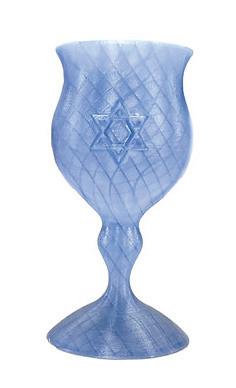
Made of recycled plastic water bottles, this Blue Box is a sustainable take on a classic tzedakah box. Each box features a removable wave-textured top to assist in easily removing tzedakah for donations.

Made from 100% recycled plastic bottles. This Yad removes 3 plastic water bottles from the environment. This one-of-a-kind piece is beautiful, spiritual, and sustainable.

Made from 100% recycled plastic bottles, this one-of-akind piece is beautiful, spiritual, and sustainable. The surface of the Mezuzah is reminiscent of Genesis 1:2 - “The Spirit of God hovers upon the water.” This mezuzah takes a single use water bottle out of the Sea and puts it on your door.

Jennifer Winters and family joined WJC in 2001. Jennifer wants to remind all congregants that the Sisterhood Gift Shop is open most Sunday mornings from 10:00 am-12:00pm and happily by appointment.




In 1986, WJC congregants danced around a Holocaust Torah as they walked from Gerhard Spies’ home to the synagogue. The Torah, which was more than 150 years old at the time, was brought over from England. It was one of more than 1,500 Torahs confiscated from European synagogues by the Nazis.
 —Jill Caslin and Katie Schlientz
—Jill Caslin and Katie Schlientz
For updates, events, photos, and more please visit us on Facebook and Instagram at @westchesterjewishcenter
